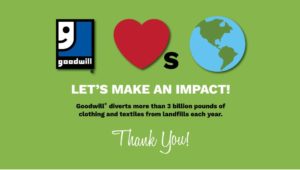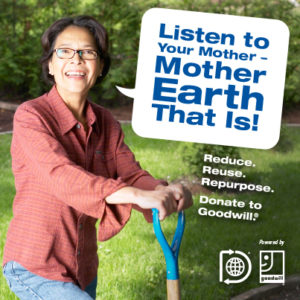Fast Fashion vs. Slow Fashion: What’s the Difference?
Here at Goodwill, we often talk about how donating your gently-used clothing is a positive choice””for you and the planet. Donating and recycling play a significant role in a “circular economy,” which stresses keeping clothing out of landfills. Donating to Ohio Valley Goodwill helps to divert millions of pounds of items from landfills, which impacts the sustainability of the environment.

Let’s Make an Impact
By cleaning out your closets and donating to Goodwill, you’re helping to make a big difference! But don’t just take our word for it, take a look at this recently-collected data that relates to the clothing industry:
- 11 million tons of textiles are wasted in the United States each year
- Three-fifths of all clothing items produced make their way to an incinerator or landfill within one year
- Only an estimated < 1 percent of the material used to produce clothing is repurposed
As eye-opening as these statistics may be, there is encouraging news. An increasing number of consumers say they want to live more sustainably. In fact, 60% of millennials say so, and 75% across the world do, too!
But what exactly is driving so much of the waste in the fashion industry? Even more importantly, what we can do about it?
The history of ” fast fashion”
Although the concept of “fast fashion” can be traced back to the Industrial Revolution””when suddenly clothing could be mass-produced””the contemporary definition came about around 20 years ago. With the introduction of fast fashion, clothing can be made quickly, inexpensively, and sold in stores at extremely low prices.
While fast fashion might sound like a good idea, there are some significant downsides. Fast fashion not only speeds through production to the shelves, but it also moves quickly through consumers’ hands into the garbage. The constantly changing trends and low price tags of fast fashion clothing only fuel the need to shop and buy more to have the latest styles.
The result is that everything is considered easily disposable when the next trend comes around. In the end, more reusable clothing items wind up in landfills, where they can take months or even years to break down fully.

Reduce, Reuse, Repurpose graphic
Slow down on fast fashion
Wasteful shopping habits aren’t the only downsides of fast fashion. Other factors include:
- Low-quality fabrics that degrade after just a few washings
- Synthetic materials that don’t break down in landfills
- Microfibers from cheap materials infusing our waterways and threatening ocean life
- The use of toxic dyes, pesticides and other toxins that further pollute our environment
Thankfully, there is an alternate course, fittingly termed ” slow fashion.” Slow fashion refers to clothing that is produced in fewer quantities at a much slower pace. Consumers are encouraged to choose quality over quantity and practice repeat wearing and repurposing over tossing out.
More environmental-friendly aspects of slow fashion include:
- Clothing and accessories are often made from high-quality materials that have minimal impact on the environment
- Slow fashion has a ” long life,” meaning it can be repurposed and reused by multiple people over time
- Garments are often produced locally from people who are invested in their communities
When you choose ” slow fashion” over ” fast fashion,” you can have confidence that your clothing items won’t cause significant damage to the planet and will last longer in your wardrobe!
Ditch the dumpster and donate instead
When you’re ready to clear out your wardrobe and get rid of a clothing item, ditch the dumpster and protect the planet by donating to Goodwill instead. When you donate to Goodwill, your well-loved clothes will be resold at affordable prices in our retail stores and given a new life in someone else’s closet!

Goodwill’s Cycle of Success
Every time you donate to your local Ohio Valley Goodwill store, you’re not only helping to preserve the planet, but you’re also helping someone learn new skills, find a job, and achieve a sense of independence. This is because the revenue generated by the sale of your donated items helps to support Ohio Valley Goodwill’s job skills training programs and employment services for people in the local community.
Changing lives through the power of work has been the Goodwill mission for 100+ years! Last year alone, more than 3,500 individuals received skill training, career development, job placement, and life enrichment opportunities as well as the support needed to be fully integrated into their home communities.
Become a job creator and do your part to preserve the planet by donating to Ohio Valley Goodwill and shopping in our stores. To find your nearest donation site or retail store, click here. As always, thank you for supporting Ohio Valley Goodwill!



